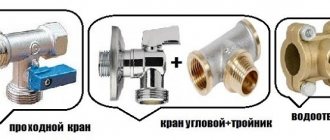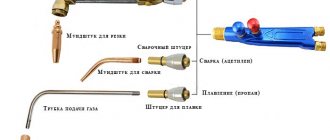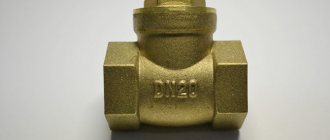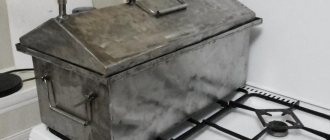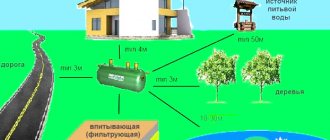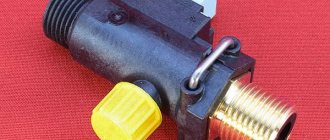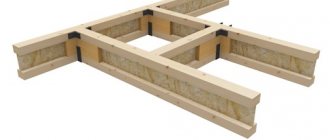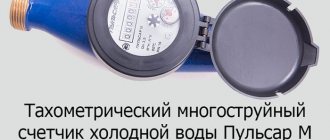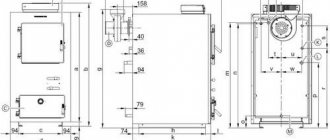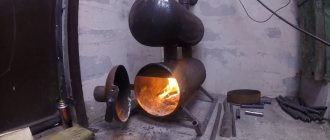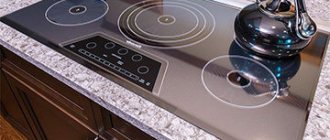Oxygen
Oxygen hoses were often used in Soviet times, since there were simply no other options for connecting via flexible hoses. Now this product fades into the background. Cost - from 60 rubles per linear meter without tips.
p, blockquote 8,0,0,0,0 –>
p, blockquote 9,0,0,0,0 –>
- ability to withstand high pressure (up to 20 atmospheres);
- ease of installation;
- cheapness;
- does not conduct electricity;
- can be selected to suit any pipe diameter.
p, blockquote 10,0,1,0,0 –>
At the same time, oxygen products are short-lived and require careful attention:
It is important to remember that the oxygen connecting hose is not a special gas hose; it is needed for other purposes, so it is better not to use it unless absolutely necessary.
Subtleties of operation
When operating flexible gas hoses, like all gas equipment, safety regulations must be strictly observed. Gas is an object of increased danger and requires the unconditional fulfillment of a number of important conditions.
- The room where gas equipment is installed must be equipped with a ventilation hole, and the vent or window must open freely. This requirement is due to the need for an influx of oxygen to support combustion.
- Immediately after installing or replacing the flexible hose, it is necessary to ventilate the kitchen, make sure that the burner and oven controls are in the off position, lubricate all connections with a solution of laundry soap, and only then open the gas supply valve located on the main pipe.
- If soap bubbles appear at the threaded connections, you should immediately turn off the gas valve and take measures to reseal the joints. If bubbles do not appear, then you can proceed to a test run of the oven without removing the soap solution from the joints. This is necessary in order to monitor how the connections will behave under pressure.
- The burners should be lit with a special piezo gas lighter or matches. The use of gasoline models, as well as gas lighters of smokers not suitable for this purpose, is prohibited.
- Before lighting the oven, it is recommended to open the cabinet door and ventilate it for a few minutes. Then you need to twist the paper string, light it from the flame of a match and light the burner.
- After all the burners and the oven are turned on, you need to once again check the threaded connections of the flexible hose for the presence of bubbles; if there are none, remove the soap solution with a damp cloth.
- Burning of blue fuel should proceed evenly, without jerkiness and flashes of fire, which can lead to the release of carbon monoxide and deformation of the burners. The flame should have a bluish-violet hue without red-yellow flashes, and its height should be no more than 2.5 cm.
- When cooking, it is important to ensure that the flame barely touches the bottom of the pan and does not go beyond it. Otherwise, when gas comes into contact with the cold surface of the bottom, the effect of “chemical underburning” occurs, leading to the risk of CO2 formation. In this regard, the flame height must be adjusted.
- It is prohibited to heat premises with gas stoves, trust their use to persons under 18 years of age, or leave them turned on unattended.
- If the flame suddenly goes out, a gas smell appears, or the color of the fire changes, you should immediately turn off the main valve and call a gas service specialist.
- At the end of cooking, turn off the gas supply valves on the stove, and then on the main pipe. After a while, you can also close the window.
- It is necessary to periodically inspect flexible gas hoses and try not to miss the deadline for replacing them. It is recommended to wash your sleeves at least once a month, using a weak solution of laundry soap or soda.
- If a gas furnace with electric ignition begins to generate electric current, you must immediately stop using it and call a technician.
To learn how to install hoses for a gas stove, see the following video.
Source
Rubber-fabric
The cheapest of specialized components from 120 rubles for 0.5 meters with tips (finished product). The rubber-fabric hose has:
p, blockquote 13,0,0,0,0 –>
- relatively short service life, on average from 5 years depending on the quality of the materials used;
- insufficient level of rigidity;
- low permissible temperature;
- product length from 0.4 to 7 meters.
Read also: What is injection molding
p, blockquote 14,0,0,0,0 –>
Otherwise, it’s a good option for connecting a stove, which has its advantages:
p, blockquote 15,0,0,0,0 –>
- high level of electrical insulation;
- wide range (easy to find for any pipes);
- Thanks to its softness, it can be easily trimmed to suit existing conditions.
You can install the product yourself, but it is better to contact a specialist.
Types and designs
Rubber product
There are three types of flexible eyeliners, which differ in material.
- Polyethylene water hoses. Their advantage is high levels of flexibility.
- Rubber hoses that are braided with stainless steel, nylon or reinforced with aluminum.
- Flexible stainless steel liner (corrugated tube).
Each type of eyeliner has its pros and cons. Rubber hoses reinforced with aluminum will last up to three years. Boundary pressure is 0.5 MPa, and temperature resistance is up to 80 degrees. The main disadvantage of aluminum reinforcement is its poor corrosion resistance. The stainless steel coated hose is much more durable than the previous one. It can withstand pressure up to 1 MPa, and a maximum temperature of 95 degrees. Such models will last up to ten years. Rubber hoses braided with nylon can be used for up to 15 years, withstand pressures of up to 2 MPa and temperatures of up to 110 degrees. Polyethylene liners, despite strict operating temperature restrictions, are considered reliable due to their high corrosion resistance.
There are two types of bellows hoses - seamless and welded. The wall thickness of the liners is about 0.3 mm in both cases. The hoses are supplied with union nuts, which are made from the same steel as the hoses themselves. In rare cases the material differs and the nuts may be brass or bronze with chrome or nickel plating. The connecting diameters of the nuts can be 1.2 inches, as well as ½, 3/4, 11/4, 11/2 inches. The permissible pressure ranges from 10 to 20 bar.
Flexible design
Flexible connections for the mixer are mounted using a retaining ring. This is a special additional element that ensures high-quality joining of the seam with a pipe or fitting during the installation process.
To properly connect the bellows pipe to the fitting equipment, brass or steel adapters are used. They are especially necessary if the cross-section of the pipes differs from the diameter of the liner.
An important and reliable part that is included in the bellows liner is the sealing gasket. It can be made from fluorine-containing polymer, copper or paronite. This element can withstand the same pressure as the tube itself, so its minimum thickness should be at least 2.5-3 mm.
Stainless steel is a high-quality and reliable material that will serve for many years. It is resistant to corrosion, aggressive chemicals, and temperature changes. The service life of bellows liners reaches 20 years, and the operating temperature can range from -40 to +200 degrees. Such products can withstand pressure up to 3 MPa.
Advantages of bellows liners
Advantages of using stainless steel bellows connections for mixers:
- Health safety due to environmental friendliness of stainless steel;
- Fire resistance of the material;
- Resistance to oxygen diffusion;
- Good wear resistance.
During installation, the bellows hose is not pinched during bending and does not lose its cross-sectional shape. Therefore, pressure indicators along the length of the hose remain unchanged.
Disadvantages of bellows hoses
Low flexibility is the main disadvantage of bellows pipes. If installation space is limited, flexible rubber water hoses are a better choice. However, the poor flexibility of bellows connections allows installation without additional fasteners - the product itself holds its shape.
Another drawback is extraneous noise from vibrations of corrugated tubes, which increases if several water consumers are turned on at the same time. This problem can be easily solved by installing a plastic sleeve - the sound of vibration will be muffled.
The disadvantages also include the high price of bellows liners. But this is compensated by a long service life compared to other products.
With metal braid
It has an optimal ratio of price, quality and durability. Price from 140 rubles per 60 cm of finished product. The hose is made of vulcanized rubber and reinforced with textile thread. The outer part is a metal braid.
p, blockquote 17,0,0,0,0 –>
The gas hose is similar to the water supply (for the toilet, taps, shower). You can distinguish it by markings: plumbing products have blue and red marks for cold and hot water, and a yellow thread is woven into the braid of gas products.
p, blockquote 19,0,0,0,0 –>
One of the most common options, the popularity of which is associated with many positive qualities, including:
p, blockquote 20,1,0,0,0 –>
- high level of reliability;
- ease of installation;
- longer service life compared to rubber products;
- large selection of lengths and diameters;
- permissible temperature has a wide range from -35 to + 50 degrees;
- ease of use.
It is prohibited to use the product without installing a dielectric insert!
Reliable signs of a fake
Regardless of the type of flexible gas hose, you should ensure the authenticity of the product before purchasing. The fact is that recently cases of defects and counterfeits launched for sale by Chinese manufacturers have become more frequent.
Well-known European brands are usually the targets of counterfeiting. The difference in quality between the original and the fake can be colossal.
It is possible to play it safe and distinguish a quality product from a counterfeit one. To do this you need:
- take the time to conduct a thorough visual inspection;
- check whether the technical characteristics correspond to those indicated in the product passport;
- require the seller to present quality certificates confirming the safety of the device intended for working with explosive substances;
- do not buy goods at a suspiciously low price, which is not typical for products in this category.
The structure of counterfeit goods may contain dangerous chemical or radioactive impurities. Defective hoses are short-lived and often cause explosions.
PVC reinforced
PVC gas line is one of the latest developments. It does not conduct electricity, does not break down like rubber, and is almost as durable as a bellows hose. It has 2 layers: an inner one made of black PVC, and an outer shell made of yellow PVC. Due to their novelty, not all gas services accept them for operation, so it is better to consult an authorized organization in advance. Price for 60 cm of product - from 140 rubles.
p, blockquote 22,0,0,0,0 –>
p, blockquote 23,0,0,0,0 –>
Properties of reinforced PVC hoses:
p, blockquote 24,0,0,0,0 –>
- flame retardant;
- dielectric;
- withstands hot plate contact test;
- quite cheap with a comparable service life;
- resistant to oil mist;
- operated under conditions of increased loads;
- meets the requirements of GOST R 52209-2004, GOST12.2.063-81, GOST12.2.003-91;
- guaranteed service life - 12 years, actual service life - more than 20 years;
- length from 60 cm to 5 m.
Which hose is better to buy
Before purchasing, you should decide on the hose material:
- Rubber ones do not twist or break;
- Silicone ones are not afraid of sudden temperature changes and aggressive liquids;
- The most durable and resistant to high pressure are PVC models.
The length is selected individually and depends on the specifics of future use. The optimal solution would be to purchase a hose that is long enough to freely and conveniently connect equipment without visible tension (that is, with a margin of at least 30-50 cm).
The diameter of the model is determined by the dimensions of the connecting elements of the equipment. The most common hoses for use in various conditions are ½″ and ¾″ in diameter. Heavy duty applications may require an inch or more of hose.
One of the main indicators is the maximum operating pressure. It is influenced by various factors, including the design of the hose, the properties of the material, etc. The best solution for long-term use would be to purchase a model designed for pressures above 10 bar.
The ease of working with the hose and the reliability of the connections largely depend on the fasteners. When purchasing, you should check that the kit contains the necessary clamps, clamps, plugs, fittings, etc.
Bellows
Bellows tubes are most often recommended by gas equipment installation specialists. This option is the most reliable and most expensive. But given the very long service life (up to 30 years), its cost is justified. Price from 170 rubles for 60 cm of finished eyeliner.
p, blockquote 25,0,0,0,0 –>
Bellows (from the English brand name Sylphon) is an elastic single-layer or multi-layer corrugated shell made of metal, non-metallic and composite materials that maintains strength and tightness under high-cycle deformations of compression, tension, bending and their combinations under the influence of internal or external pressure, temperature and mechanical stress . (https://ru.wikipedia.org/wiki/Bellows)
The bellows hose is made of stainless steel, with a PVC coating on top. This ensures that it will last a long time: the average lifespan is 25–30 years. The metal braid reliably protects from mechanical influences, and the polyvinyl chloride coating provides electrical insulation and resistance to chemicals. Thanks to the corrugated surface, the product bends easily.
p, blockquote 27,0,0,0,0 –>
p, blockquote 28,0,0,0,0 –>
Bellows gas hose has the following advantages:
p, blockquote 29,0,0,0,0 –>
- can be connected to any gas equipment: stoves, boilers, etc.;
- has connecting dimensions 1/2″, 3/4″, 1″;
- has excellent flexibility;
- withstands pressure up to 6 atmospheres;
- wide range of operating temperatures: from -50 to +250 degrees (installation outdoors is allowed; nothing will happen to it if it comes into contact with hot surfaces);
- able to withstand mechanical loads, aggressive environmental influences, and household chemicals;
- hoses comply with the requirements of GOST R 52209-2004, GOST12.2.063-81, GOST12.2.003-91;
- warranty service life - up to 15 years;
- service life – up to 30 years;
- is able to ensure the tightness of the system even under extreme loads, for example, during an earthquake.
The length of the bellows gas hose varies depending on the manufacturer.
p, blockquote 30,0,0,1,0 –>
With Emiflex, the eyeliner can increase in size by 2 times and has the following parameters (in meters):
p, blockquote 31,0,0,0,0 –>
- from 0.26 to 0.52;
- from 0.5 to 1.0;
- from 0.75 to 1.5;
- from 1.0 to 2.0.
And the hoses have a fixed length (in meters):
The only thing that can scare off a buyer is the price. But considering its durability, it is the most profitable purchase.
Do not use the hose without installing a dielectric insert!
p, blockquote 34,0,0,0,0 –>
Gas connection Lux Highest level of safety
In civilized countries, safety requirements for gas supply equipment are constantly becoming more stringent. And this is justified, since gas does not forgive careless handling. We are pleased to offer our customers a product that meets the most modern European safety standards EN 14800:2007 and is supplied to Western European countries.
This gas supply has a number of design features that guarantee reliability and durability:
-Fittings (nuts, fittings) are made not of carbon steel (the so-called carbon steel), but of AISI 303 stainless steel. This eliminates rusting of the fittings when used in rooms with high humidity. -The bellows metal hose has an external stainless steel braid along its entire length , which acts as a reinforcing frame. -The bellows in a metal braid is placed in a protective shell that is resistant to heat. The shell expands the range of operating temperatures - this is especially important when connecting built-in gas equipment (hobs, ovens), since in built-in kitchens the hose is located in closed spaces with poor air circulation.
Ambient temperatures in such locations can exceed 100 degrees Celsius, which is already above the normal operating temperature for unsheathed hoses. Operating temperature: -20…..+140 degrees Celsius (shell heating temperature up to 120 degrees). — The protective sheath is rigidly fixed to the hose with compression sleeves.
Gas line 1/2″ in a shell: BUY RETAIL! Gas line 1/2″ without sheath: BUY RETAIL! Gas line 3/4″: BUY RETAIL! Gas line 1″: BUY RETAIL!
Rules for choosing a gas hose
A few simple tips will help you choose a gas hose, save time and money, and avoid troubles with energy leaks:
p, blockquote 35,0,0,0,0 –>
- Buy any products only in specialized stores, and do not forget to ask the seller for a quality certificate.
- You cannot buy Chinese hoses: they are thin and quickly become unusable. There are also many fakes.
- The slabs are connected only with those sleeves that have a special yellow mark. They cannot be replaced with plumbing ones. The latter are not designed for such loads and wear out in a few weeks.
- When purchasing, the eyeliner must be carefully inspected for damage.
- Select the size so that the product sags and does not stretch.
- Pay attention to the mounting methods - fitting or nut - select them according to size.
Important! For a stove with electric ignition, you need to buy a fireproof flexible liner with insulators in the form of white plastic rings between the nuts and braid, or use a dielectric insert.
p, blockquote 37,0,0,0,0 –>
Read also: How to distinguish lead from tin
Main types of gas stoves
Today the household appliances market has a wide range of products. Kitchen stoves have a huge number of varieties. Gas stoves are no exception. Despite their narrow specificity, they have the following varieties:
- Gas stoves with gas oven
- Gas stoves with electric oven
A gas oven is more economical than an electric one. And electric ovens have more functions and modes than gas ovens:
- Upper and lower grill
- Food heating modes
- Defrost modes
- Steam cooking modes
- Convection mode
- Oven cleaning mode
Such a variety of modes will make cooking on a gas stove not only economical, but convenient and maximally functional.
Installation recommendations
When installing the hose, use the following recommendations:
p, blockquote 38,0,0,0,0 –>
- The hose must be laid in an easily accessible place. It is not safe to hide it in a wall or under the floor.
- The bending radius should not be less than three times its diameter.
- The product must not be pulled, twisted, bent, or painted.
- Metal parts must be protected from condensation, which leads to oxidation of the material.
- You cannot connect steel elements (tips) with copper ones, this can lead to electrolytic damage to the product. Acceptable combinations are steel with steel, brass with copper.
- All connections must be tightened tightly, but without excessive force, so as not to damage the threads.
- A dielectric insert is installed between the tap and the gas hose, which prevents the accumulation of stray currents, which can lead to overheating of the braid, damage to the device, and melting of the rubber.
Connection instructions and features
Regardless of the type of connection, the connection is carried out according to certain requirements:
- The length of the sleeve corresponds to the distance at which the household appliance will be located from the gas source. The riser has branches that end in taps. The product must not be equipped with additional couplings or connections.
- Before connecting the hose, preparatory work is carried out. The gas supply is cut off at the central riser in the apartment. The household appliance must stand level so that there are no distortions in the hose connection.
- A seal is applied to the hose fitting and it is screwed on when the pipe is released. If the threads on the device and the diameter of the tube do not match, an adapter will be required. A seal is also used for it to prevent gas leakage.
- Checking the tightness of the connection. To do this, apply a soap solution to the joint. If bubbles are not blown in, there is no problem.
Gas line service life
After installing the hose, you should check its service life and remember the installation date. The product, depending on the type, is designed for a period of 5 to 15 years. It is important not to forget to replace it on time.
p, blockquote 39,0,0,0,0 –> p, blockquote 40,0,0,0,1 –>
Guaranteed service life is indicated in the product passport and in the certificate of conformity.
- rubber hoses (with and without sheath) – 5-year warranty, service life up to 10 years;
- PVC eyeliner – 12-year warranty, lasts up to 20 years;
- bellows gas hose - 15 year warranty, does not require replacement up to 30 years.
The gas heating boiler is connected to the main line using a flexible hose.
Choosing and installing a hose for a boiler is a very important matter , because we are talking about gas.
An incorrect connection to the gas pipeline may result in an explosion .
To supply household gas, flexible gas hoses specially designed for this purpose are used. The use of water hoses for this purpose is strictly prohibited.
What is a hose for a gas pipe? The main requirements for the product
In appearance, the hose for connecting a gas stove is very similar to a water supply. The main difference between a gas device is the presence of yellow or white markings, which should be visible. In addition, the flexible hose for the gas stove is made of a special material. Another feature is the presence of a paronite gasket - a special ring that is used to seal the flange connection. It is the presence of the gasket that ensures the safety of using the products.
In appearance, the hose for connecting a gas stove is very similar to a water supply
Purchasing a high-quality and certified product will ensure the safe use of gas, but purchasing a hose of dubious quality without the appropriate documents can lead to tragedy. Other mandatory requirements for a flexible gas hose for a stove:
- The product must be complete, without additional couplings, extensions or connections.
- It is necessary that the flexible liner have a special coating that is resistant to hot liquids and high temperatures.
- The hose must not be subject to corrosion.
- The parameters of the product must correspond to the characteristics of the gas used.
- The service life of a gas hose for a gas stove should not be less than 10 years.
It is unacceptable to connect several hoses together - it is better to immediately purchase a hose for a gas stove, the length of which will correspond to the distance between the gas pipe and the hob. The maximum length of a gas hose for connecting a stove according to European standards is 2 meters, although a seven-meter hose is considered the longest certified product. If you look at the relevant Russian GOSTs, you will notice that they do not contain recommendations regarding the length of the gas hose. In any case, you should not install the stove too far from the gas pipe.
The main types of hoses include: oxygen, rubber reinforced, rubber-fabric, reinforced PVC hoses, bellows
Now the market offers a large number of different options for mobile gas connections. The materials used in production also differ in technical characteristics that affect their service life. Therefore, in order to understand what the hose for a gas stove should be like in a particular situation, you need to take into account the location and features of use of the hob. The main types of hoses include:
- oxygen;
- reinforced rubber;
- rubber-fabric;
- reinforced PVC hoses;
- bellows.
Varieties
three types used in everyday life :
- Rubber-fabric.
- Rubber reinforced.
- Bellows.
They are made from various materials, have different technical properties and service life. Each of the three types of gas hoses has both pros and cons. The choice depends on the installation location and the specific case.
Rubber
Rubber hoses reinforced with textile thread are the softest among all types of hoses. They are economical, easy to install and maintain. A wide selection of hoses of this type is available in construction stores. You can easily choose a sleeve of the desired length and diameter .
Photo 1. Rubber soft gas hose, black, is economical and easy to connect.
Rubber gas hose is mainly used in dachas. This method of gas supply is the most affordable and easy to install, but also the most unsafe. Over time, the rubber cracks, which inevitably leads to gas leakage, so the use of this type of connection is only permissible for private sector gas cylinders.
In addition, these hoses lack rigidity and are sensitive to temperature changes. This type of hose is recommended to be replaced every two years, however, in practice they are used much longer. Modern sleeves with elastic components can last up to 5 years .
Reinforced
Much more common are reinforced rubber hoses, which are similar to water supply hoses. They are braided with steel threads on the outside. The inside is made of polymer material, although they are called rubber.
Reinforced hoses are also affordable and easy to use, but they are prohibited in several European countries . Our gas specialists also do not recommend using them or doing so in compliance with a number of rules.
Photo 2. Two reinforced hoses made of polymer material, one covered with corrugated steel on top.
The polymer sleeve inside is destroyed in the same way as the rubber one. In addition, steel is an excellent conductor of current, so it is necessary to use dielectric spacers during installation. When using metal-braided tubes, be sure to turn off the gas taps; this will extend the service life of the hoses. This type of hose can be used at temperatures up to +50 degrees.
Read also: What is the difference between a jackhammer and a hammer drill?
Bellows type stainless steel
This is the only type of gas hose approved for household use. It is a dense corrugated braid that is resistant to high and low temperatures, high pressure and mechanical stress. There is a single-layer and multi-layer bellows.
It is made from both metallic and non-metallic materials. The shell creates increased safety; it prevents damage from most types of impacts.
Photo 3. The bellows gas sleeve is yellow, made of non-metallic material, coated with polymer.
This type of hose is made of stainless steel. Gas hoses are sold with and without insulation. The second type is coated with a polymer that does not conduct electricity. A hose with a diameter of at least 10 cm for uniform gas supply. Bellows hoses are an order of magnitude better in quality than others.
Reference! The most reliable samples are those with a polymer coating that protects them from environmental influences. These gas hoses last up to 30 years , they are safer, but also more expensive.
Advantages of bellows hoses for gas:
Description
The hose for a gas stove is a flexible pipe designed to connect a household appliance to the main gas pipeline using threaded connections. The main advantage of gas hoses is their ability to provide a tight connection in compliance with all safety requirements, as well as high elasticity, allowing the device to be moved after connection. The flexibility of gas hoses is especially important when installing kitchen units, when it becomes necessary to slightly adjust the location of the stove.
How to choose the right flexible gas tube?
It is safest to purchase a gas hose in a specialized store that has a state certificate of conformity . It is best to opt for the bellows type of sleeve.
Important! Beware of fakes of poor quality. There is a high probability of purchasing counterfeit goods on the market. This threatens that the sleeve will be made of thin, cheap rubber, which will quickly fail. Most fakes can only be distinguished from the original by a professional.
To identify a counterfeit, you need to carefully study the technical characteristics of the product, passport and certificate of conformity. You should not buy a product at a suspiciously low price.
Before purchasing, you need to take a measurement, then add 20% . You should not purchase a gas hose with a reserve. Standard sizes are 1–2 m. In everyday life, diameters of 1/2 or 3/4 inches are usually used.
The hose comes with two types of fastenings: with two union nuts with internal threads (female-female) or with a nut on one end and a fitting on the other (female-male). The thread is selected depending on the outlet on the device. It is preferable to opt for welded structures rather than those where the fitting is connected to the corrugation with glue.
Installation
The safest thing to do is contact a professional who will ensure the correct connection and provide a guarantee. After all, everyone knows from childhood that it is dangerous to joke with gas.
An unqualified connection to a gas pipeline can lead to an accident; everyone has seen the consequences of a domestic gas leak in the news.
However, a modern gas hose allows you to independently connect the boiler to the mains. Any adult can carry out installation while observing safety precautions
When working, you must adhere to the following rules:
- The length of the line is selected taking into account the distance over which the equipment is likely to be moved.
- The system is located in a place accessible for inspection.
- There must be no other connections on the device
- The product cannot be painted to avoid cracking of the material.
- The dimensions of gas hoses must comply with GOST standards.
- Do not twist, bend or strain the sleeve.
- Do not solder or weld the connection.
- Replace the hose with a new one in accordance with the manufacturer's recommendations.
Connection to the gas pipeline
To install the gas hose to the riser you will need an adjustable wrench, a screwdriver, a sealant, a brush and a soap solution.
First you need to prepare the room and shut off the gas supply to the network. Then the boiler is installed at the installation site and carefully leveled.
Each apartment has a gas riser , which has branches with taps at the ends, this is called a release.
A sealant is applied to the hose fitting and screwed into the tap during release. If the diameters do not match, then an adapter is needed, which is also sealed. The hose is connected to the boiler.
The system is then tested for leaks. To do this, use a brush to apply a soap solution to the joints and slightly unscrew the valve. If the connection is leaky, the solution will begin to bubble, otherwise nothing will happen. If a leak is detected, it is necessary to turn off the gas and check the winding of the seal.
Lastly, the equipment is checked for functionality and gas is supplied.
Attention! If you have any doubts, the best solution is to contact a specialist. The technician will connect the gas safely, reliably and in compliance with all regulations, and will also guarantee the correct operation of the system for many years.
The main types of breakdowns of gas stoves and ways to eliminate them
A gas stove is a complex and dangerous type of household appliance, and any malfunctions must be treated with special attention. Common types of gas stove failures are the following:
- The burner does not light, the gas pressure is low - only the gas service can fix it
- The burner channels are clogged - it’s quite possible to clean it yourself
- The burner is not installed correctly - you can reinstall the burner yourself
- There is a gas leak - you need to turn off the gas and call the gas service
- The connections in the threads are loose - it is necessary to clean and seal the threads
- There is no tightness in the taps - it is necessary to disassemble the taps and lubricate them. If you have the appropriate skills, you can do this yourself
- The contacts have oxidized - repairs are carried out by a technician by cleaning the contacts with sandpaper
- Solenoid valve failure
- Failure of electric ignition - diagnostics are necessary to identify the cause of the malfunction
- Increased gas pressure - you need to reduce the gas pressure yourself or call a specialist
It is not recommended to try to fix the problem yourself without knowledge and experience; it is better to entrust such types of repairs to a professional technician in order to avoid more serious further breakdowns.
Reinforced hoses: polymer, rubber, steel
Polymer materials are located inside such a hose. The next layer is vulcanized rubber. On the outside, it is braided with steel threads. In order not to confuse the products with similar water hoses, a yellow thread is woven into them.
Reinforced hoses are quite popular, the reasons for which are:
- simple installation and ease of operation;
- reliability and decent shelf life;
- variety of assortment - both in diameter and length;
- safe use at temperatures from -35° to +50°.
Let us also note a significant disadvantage - the unimportant level of electrical insulation, the culprit of which is the metal braid. Therefore, when installing, you usually have to insert a dielectric coupling between the plate and the supply line. There is another drawback - the unreliability of the internal polymer material. For this reason, they have become “persona non grata” in some European countries, and recently the same trend has been emerging in our country.
Bellows hoses: the favorite among specialists
The greater reliability of bellows hoses is the reason for their indecently high price. They are made of stainless steel and covered with polyvinyl chloride on top. These products can guarantee your safety for 25-30 years, and this figure is an average value.
The corrugated surface and metal braid provide protection from mechanical damage, and resistance to chemicals and electrical insulation are provided by the PVC coating. Let's list all the advantages:
- Widely used to connect any equipment;
- impressive temperature range - from -50° to +200°;
- ability to withstand pressure of 6 atmospheres;
- guarantees preservation of tightness even in extremely unfavorable conditions.
Connection to a domestic stove
On the back side of the plate we find the entrance - the fitting. The receiver can be straight or corner. With a direct entrance, when the gas riser is located to the side, there is a need to purchase a metal corner with an internal thread and a limiter into which paronite gaskets are placed. When installing, make sure that the sleeve does not have strong kinks.
The outlet thread may be ¾ or 3/8 inch, in which case you will need a ½ inch thread. Basically, the gas riser is located in the corner of the kitchen. There is a tap coming from it. The sleeve you have is screwed or screwed onto it, depending on the thread on the valve.
The sleeve must include two paronite gaskets. They must be used during installation to avoid natural gas leaks. You can use a gasket with a fine mesh if you are afraid of the possibility of mechanical inclusions in the gas mixture. We fasten the hose with a wrench, without excessive force, the paronite should not protrude from the connection.
Next comes a check for a possible gas leak. Soap foam is applied to the connections. If there are no bubbles, you can safely start using the safely connected stove.
Safety rules when using gas stoves:
- constant free access to the gas hose;
- additional connection of devices to the gas stove is prohibited;
- the hose must be kept clean, painting is prohibited;
- the hose must have sagging, otherwise there is a risk of breakage or leakage at the joints;
- when planning, allow a distance in the length of the hose (maximum hose length 4.5 m) that is optimal when moving the stove in case of cleaning or repairs; when moving, turn off the gas supply;
- avoid bending and twisting of the sleeve;
- protect the metal braid from condensation;
- the connection must be threaded, soldering or welding is prohibited;
- Replace the hose promptly when its service life expires.
How to distinguish a fake?
Regardless of the type of flexible gas hose, you should ensure the authenticity of the product before purchasing. Well-known European brands are usually the targets of counterfeiting. The difference in quality between the original and the fake can be colossal.
It is possible to play it safe and distinguish a quality product from a counterfeit one.
To do this you need:
- take the time to conduct a thorough visual inspection;
- check whether the technical characteristics correspond to those indicated in the product passport;
- require the seller to present quality certificates confirming the safety of the device intended for working with explosive substances;
- do not buy goods at a suspiciously low price, which is not typical for products in this category.
The structure of counterfeit goods may contain dangerous chemical or radioactive impurities. Defective hoses are short-lived and often cause explosions.
What else you need to know about bellows eyeliner
Today you can purchase a flexible connection for a mixer in a store of relevant goods; this also applies to bellows connections, which, although expensive, have found their way among consumers. This product is a corrugated hose made of stainless steel. At the ends there are fittings made of stainless steel. Such a line must be fixed to the gas inlet pipe or equipment using union nuts. Be sure to use metal gaskets, which must be soft, this includes aluminum or copper. Special plastic can also be used as a gasket material.
This flexible stainless steel line can have corrugations and fittings made of different materials. However, experts recommend purchasing products that are entirely made from the same base. This requirement is due to the fact that welding different metals can cause an electrochemical reaction, which contributes to the destruction of the weld. Such a connection cannot be called strong.
